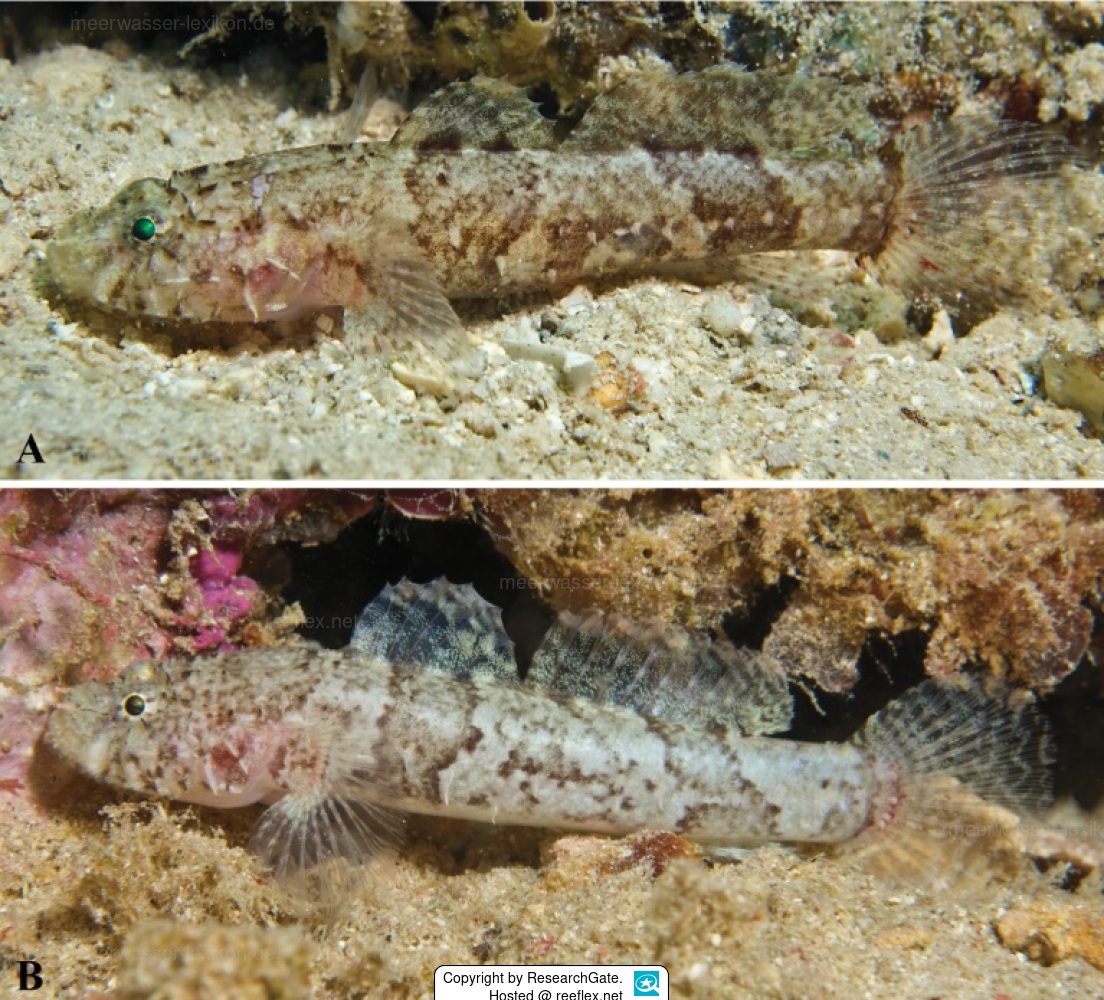Info
Callogobius bifasciatus is often found under stones or at the base of corals in seaward fringing reefs and coral patches in lagoons and bays, and also readily on coral rubble sand bottoms, where the gobies are well adapted due to their body coloration.
Callogobius bifasciatus differs from all other Callogobius species in the Red Sea by the absence of head pores.
The head, body, and median fins of the goby are finely mottled whitish and grayish brown with an irregular broad dark brown bar below the first dorsal fin, which continues as one or two spots at the base of the fin.
A second broad, oblique, dark bar extends from the middle to the posterior base of the second dorsal fin to the posterior base of the anal fin and the anterior caudal peduncle.
A dark bar can be seen at the posterior end of the caudal peduncle, at the base of the caudal fin.
On ventral half of body Broad, diffuse brown bar or spot below origin of second dorsal fin.
Sensory papillary ridges with dark brown spots are present on the head,
Pectoral fins mostly translucent with diffuse vertical narrow brown bands and sometimes dense markings in center.
Synonyms:
Callogobius clarki (Goren, 1978)
Drombus clarki Goren, 1978
Mucogobius bifasciatus Smith, 1958
Literature reference:
Authors: Delventhal, Naomi, Mooi, Randall, Bogorodsky, Sergey, Mal, Ahmad, 2016/10/31
A review of the Callogobius (Teleostei: Gobiidae) from the Red Sea with the description of a new species
DOI - 10.11646/zootaxa.4179.2.3
https://www.researchgate.net/publication/309566461_A_review_of_the_Callogobius_Teleostei_Gobiidae_from_the_Red_Sea_with_the_description_of_a_new_species/citation/download
Creative Commons Attribution License http://creativecommons.org/licenses/by/3.0
Jumping guard
A jumping guard prevents (nocturnal) fish from jumping out.
Wrasses, blennies, hawkfishs and gobies jump out of an unprotected tank in fright if their night rest is disturbed, unfortunately these jumpers are found dried up in the morning on carpets, glass edges or later behind the tank.
https://www.korallenriff.de/en/article/1925_5_Jump_Protection_Solutions_for_Fish_in_the_Aquarium__5_Net_Covers.html
A small night light also helps, as it provides the fish with a means of orientation in the dark!
Callogobius bifasciatus differs from all other Callogobius species in the Red Sea by the absence of head pores.
The head, body, and median fins of the goby are finely mottled whitish and grayish brown with an irregular broad dark brown bar below the first dorsal fin, which continues as one or two spots at the base of the fin.
A second broad, oblique, dark bar extends from the middle to the posterior base of the second dorsal fin to the posterior base of the anal fin and the anterior caudal peduncle.
A dark bar can be seen at the posterior end of the caudal peduncle, at the base of the caudal fin.
On ventral half of body Broad, diffuse brown bar or spot below origin of second dorsal fin.
Sensory papillary ridges with dark brown spots are present on the head,
Pectoral fins mostly translucent with diffuse vertical narrow brown bands and sometimes dense markings in center.
Synonyms:
Callogobius clarki (Goren, 1978)
Drombus clarki Goren, 1978
Mucogobius bifasciatus Smith, 1958
Literature reference:
Authors: Delventhal, Naomi, Mooi, Randall, Bogorodsky, Sergey, Mal, Ahmad, 2016/10/31
A review of the Callogobius (Teleostei: Gobiidae) from the Red Sea with the description of a new species
DOI - 10.11646/zootaxa.4179.2.3
https://www.researchgate.net/publication/309566461_A_review_of_the_Callogobius_Teleostei_Gobiidae_from_the_Red_Sea_with_the_description_of_a_new_species/citation/download
Creative Commons Attribution License http://creativecommons.org/licenses/by/3.0
Jumping guard
A jumping guard prevents (nocturnal) fish from jumping out.
Wrasses, blennies, hawkfishs and gobies jump out of an unprotected tank in fright if their night rest is disturbed, unfortunately these jumpers are found dried up in the morning on carpets, glass edges or later behind the tank.
https://www.korallenriff.de/en/article/1925_5_Jump_Protection_Solutions_for_Fish_in_the_Aquarium__5_Net_Covers.html
A small night light also helps, as it provides the fish with a means of orientation in the dark!







 ResearchGate
ResearchGate

















